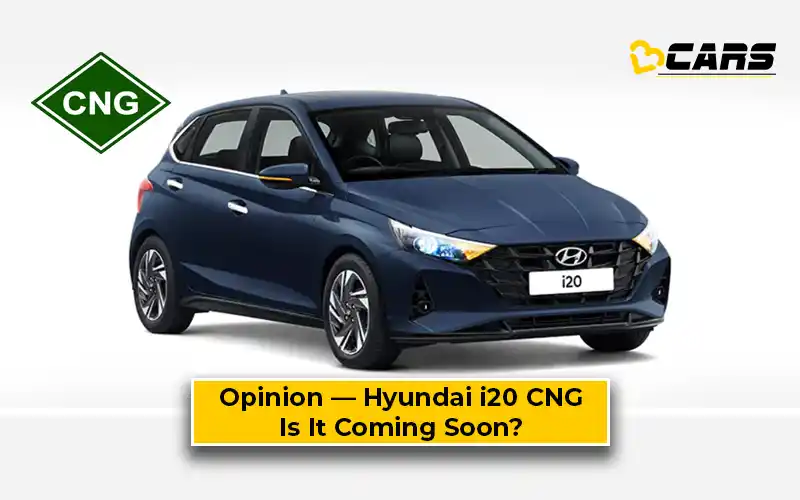Opinion — Why Hyundai Shouldn’t Wait Any Longer To Launch The i20 CNG | V3Cars
Back in 2008, Hyundai pioneered the premium hatchback segment with the launch of the i20. A decade later, the segment has expanded rapidly with several players vying for a bigger slice of the pie. The premium hatchback segment is currently led by the Maruti Suzuki Baleno while the i20 is a distant second. There’s no denying that the Hyundai hatchback offers the best features in its class. However, the i20 is now more expensive than its rivals. While B2-segment car buyers prefer a car that’s well-loaded, they still prioritise cost of ownership over anything else. This is where the i20 needs to improve, in our opinion, and here’s why Hyundai shouldn’t wait any longer to make that change.

CNG Is Now Mainstream
CNG fuel, which was earlier looked at as a cheaper alternative for commercial vehicles and low-segment cars, is now gaining acceptance and becoming mainstream. A couple of new launches have proved the potential of CNG fuel and their sales figures are a testament to the demand for CNG in the market. The Hyundai i20’s arch rival – the Maruti Nexa Baleno – recently received a CNG option to make it the first premium hatchback with the cost-effective alternative fuel option.
Note: Check your Car EMI with our - Car EMI Calculator
A couple of weeks later, Toyota not only launched the Glanza CNG but also opened booking for the Urban Cruiser Hyryder CNG — the first CNG SUV in the country. Now that’s huge for a C-segment SUV that is supposed to cater to the premium segment. This proves that there is substantial demand in the market for CNG cars and customers are fed up with the ever-increasing prices of petrol and diesel. And that brings us to diesel fuel, let’s discuss that first.
End In Sight For Diesel Cars
The Hyundai i20 and Tata Altroz are currently the only premium hatchbacks in the country that offer a diesel engine. It is astonishing to note that the i20 diesel only accounts for 11% of the hatchback’s overall sales figures and the same is true for the Altroz as well. The low sales volumes of the diesel-powered i20 and Altroz could be down to the fact that both lack the option of an automatic gearbox. However, there is no denying that the heydays of diesel-powered hatchbacks are over.
Upcoming BS6-II emission norms might prove to be the final nail in the coffin for diesel hatchbacks. While Hyundai are expected to update the Venue and Creta’s 1.5L diesel engine to make it compliant with the new norms, the chances of the i20 receiving the updated engine are wafer thin. With the diesel engine out of the picture, the i20 is left with the 1.2L normal petrol and 1.2L turbo petrol engines. This is when it becomes crucial for Hyundai to offer a cost-effective engine option for the i20 to keep prospective customers away from the Baleno/Glanza cousins.
CNG Is The Need Of The Hour
It’s no secret that CNG is currently the most sensible fuel option for cost-conscious customers. It offers a fantastic cost-per-km average with a very sensible and attainable breakeven point. For instance, considering CNG prices of November 2022, the Baleno CNG offers a km-to-breakeven at just Rs. 53,000km over its petrol variants. In short, you will have to drive the Baleno CNG for 53,000 km to recover the Rs. 95,000 premium you paid for the CNG powertrain over the petrol.
Use our fuel cost calculator to calculate Km-to-breakeven for your car - Fuel Cost Calculator India
In case of the i20, the 1.2L petrol engine is already compliant with CNG and is on sale with the Grand i10 Nios CNG. Hence, it doesn’t really require a lot of effort from Hyundai to plonk this engine into the i20 and put a dent on the sales of the Baleno and Glanza CNG. Based on the surging demand for CNG cars and their sky-high waiting periods, we think Hyundai would easily be able to sell more i20 CNGs than the i20 diesel variants.
Also Read: Opinion - Hyundai, Kia’s Mini SUV White Space Analysis


0 Comments
Hyundai Cars in India
Venue
₹7.90 - ₹15.69 lakh*
*Ex-showroom priceVenue N
Line
₹10.55 - ₹15.48 lakh*
*Ex-showroom priceCreta EV
₹18.02 - ₹24.70 lakh*
*Ex-showroom priceAlcazar
₹14.47 - ₹21.10 lakh*
*Ex-showroom priceCreta N
Line
₹16.35 - ₹20.09 lakh*
*Ex-showroom priceCreta
₹10.73 - ₹20.20 lakh*
*Ex-showroom priceExter
₹5.49 - ₹9.61 lakh*
*Ex-showroom priceVerna
₹10.69 - ₹16.98 lakh*
*Ex-showroom priceAura
₹5.98 - ₹8.42 lakh*
*Ex-showroom priceGrand i10
Nios
₹5.47 - ₹7.92 lakh*
*Ex-showroom priceIoniq 5
₹46.30 lakh*
*Ex-showroom pricei20 N
Line
₹9.14 - ₹11.60 lakh*
*Ex-showroom pricei20
₹6.87 - ₹10.52 lakh*
*Ex-showroom priceUpcoming Hyundai Cars
Next-Gen Venue
N Line
₹11.40 - ₹13.30 lakh*
*Expected PriceExpected Launch Nov 2025
Next-Gen Venue
₹8.19 - ₹13.20 lakh*
*Expected PriceExpected Launch Nov 2025
Verna Facelift
₹11.10 - ₹17.99 lakh*
*Expected PriceExpected Launch Mar 2026
Exter Facelift
₹6.19 - ₹10.89 lakh*
*Expected PriceExpected Launch Jul 2026
Exter XRT
₹8.99 - ₹11.30 lakh*
*Expected PriceExpected Launch Dec 2026
Creta 3rd-Gen
₹11.49 - ₹21.50 lakh*
*Expected PriceExpected Launch Jan 2027
Next-Gen Grand
i10 Nios
₹6.30 - ₹8.99 lakh*
*Expected PriceExpected Launch Apr 2027
Next-Gen Aura
₹6.80 - ₹9.50 lakh*
*Expected PriceExpected Launch May 2027
Stargazer
-
*Expected PriceExpected Launch Jun 2027
Verna N
Line
-
*Expected PriceExpected Launch Jul 2027
Sonata Facelift
-
*Expected PriceExpected Launch Dec 2027
Ioniq 6
2026
₹65.00 - ₹80.00 lakh*
*Expected PriceExpected Launch Feb 2028
Kona EV
Facelift
-
*Expected PriceExpected Launch Feb 2028
Staria
₹45.00 - ₹55.00 lakh*
*Expected PriceExpected Launch Oct 2028
Venue XRT
₹12.49 lakh*
*Expected PriceExpected Launch Nov 2028
Next Gen
Elantra
-
*Expected PriceExpected Launch Dec 2028
Palisade
-
*Expected PriceExpected Launch Jan 2029
Venue Facelift
-
*Expected PriceExpected Launch Mar 2029
Ioniq 5
Facelift
-
*Expected PriceExpected Launch Apr 2029
Santa FE
-
*Expected PriceExpected Launch Apr 2029
Ioniq 9
₹80.00 - ₹90.00 lakh*
*Expected PriceExpected Launch Jun 2029
Nexo
-
*Expected PriceExpected Launch Feb 2030
Latest Hyundai Cars Videos
Hyundai Venue vs Maruti Arena Brezza Sub Rs. 10 Lakh Battle | Which Car Is More Value For Money?
Hyundai Venue vs Tata Nexon Sub Rs. 11 Lakh Battle | Which Car Is More Value For Money?
Hyundai Venue vs Tata Nexon Sub Rs. 12 Lakh Battle | Which Car Is More Value For Money?
Hyundai Venue vs Tata Nexon Sub Rs. 9 Lakh Battle | Which Car Is More Value For Money?
Hyundai Verna 1.5 Turbo DCT Fuel Efficiency Test | Real-World Mileage Review
Hyundai Venue vs Tata Nexon | Sub Rs. 8 Lakh Battle | Which Car Is More Value For Money?
New Hyundai Venue Variants Explained | HX2, HX4, HX5, HX6, HX6T, HX8, HX10, N6, N10
Tata Punch vs Hyundai Exter Sub Rs. 10 Lakh Battle | Which Car Is More Value For Money?
Hyundai Exter vs Tata Punch | Sub Rs. 7 Lakh Battle | Which Car Is More Value For Money?
Kia Seltos vs Hyundai Creta | Sub Rs 15 Lakh Battle | Which Car Is More Value For Money?
i20 Important Links